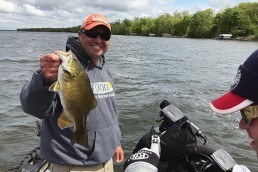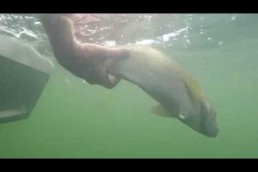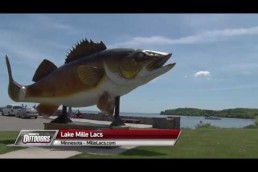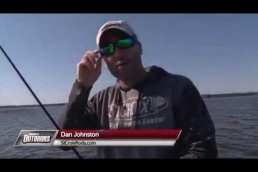Mille Lacs: Early Season Walleye and Bass Tactics
SHARE THIS POST
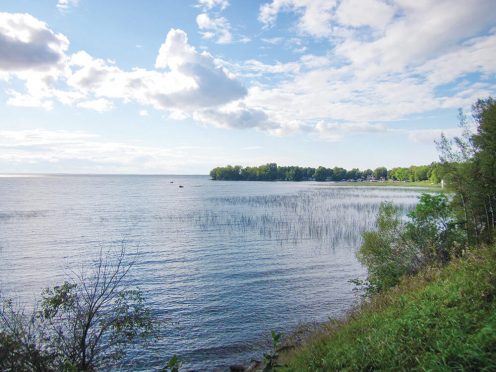 Mille Lacs
Mille Lacs
Central Minnesota’s Lake Mille Lacs is a premier destination for walleyes and smallmouth bass, and the timeframe from Minnesota’s Fishing Opener (May 9th this year) through late June is a peak window to target these top two gamefish species. Like most upper Midwest lakes, shallow-water fishing tactics should be your focus in the spring; both bass and walleyes are hanging around spawning areas and seeking warm water and baitfish in these areas. Let’s review live bait strategies for catching walleyes on Lake Mille Lacs, with a nod to some artificial presentations that catch both walleyes and bronzebacks here.
Three primary live bait techniques dominate on Lake Mille Lacs: live bait rigs, slip bobbers,and jig-n-minnow combos. You are fishing in the weed-dominated bays on the south and west sides of the lake (Isle Bay, Wahkon Bay, and Cove Bay to the south, plus Vineland and Wigwam Bays to the west). Shallow structure is predominantly rock, gravel or sand. The weedbeds are primarily old growth until water temps warm and early summer sunshine can work its magic. We’ll touch on fishing the weeds below, but let’s start with the hard-bottom areas first.
Hard-bottom fishing
Finesse live-bait rigging tactics were refined on this lake decades ago. Due to high water clarity, the typical Mille Lacs snell length is 7 to 12 feet (compared to a dingy lake such as Lake of the Woods where a three-foot snell is considered long). However, while rigging is a key tactic during the summer months when fishing the deeper main basin of the lake, live bait rigging has lost its luster for anglers fishing the early season. With the advent of zebra mussels and with water clarity at an all-time high, the days of dragging a rig below and slightly behind the boat in 10 to 12 feet of water in the shallows has gone by the wayside.
Says longtime MidWest Outdoors contributor Tony Roach: “We used to drag live bait rigs under the boat on Opener in less than ten feet of water and catch fish. Nowadays, if you’re not pitching a jig-n-minnow, jig-n-plastic, a bobber rig, or some kind of crankbait out away from your boat hull, you’re not catching as many fish as you could be. You also need to run your electric trolling motor instead of your big motor in this situation.”
That being said, once water temps reach the low 60s (usually by early June) and bug hatches start in the mud basin, live bait rigs come into play as a top tactic for catching walleyes out in the main lake.
Stealth tactics now rule the day in the shallows. On windy days, anchor up on one of the numerous shallow reefs and drift a slip bobber rig downwind to catch fish. Using the Lakemaster chip in my Humminbird units, it’s easy to position the boat upwind of a prime rockpile spot without disturbing walleyes with boat noise. A couple of tips: Re-bait often with a fresh leech, because cold water will limit the bait’s movement and reduce hookups.
Also, if more than 10 to 15 minutes elapses between bites, change the cleat position on your anchor line. This causes the boat to swing one way or the other in the wind, thereby easily (and quietly) repositioning your presentation on the reef. Remember to let out more line as well, to slide further downwind to reach new water as well. If these adjustments fail to produce more bites, it’s time to raise the anchor and reposition the boat on another spot on the reef—or move to an entirely new reef.
Shallow areas
Prefer to cast lures versus anchoring up? The shallow shoreline bite offers tremendous appeal. Walleyes mostly will be extremely shallow—less than ten feet of water—to start the walleye season in mid-May. Water temps will be in the mid-50s at best. Roach says, “It’s become more important than ever to get your lure out away from the boat—especially in these shallow spots—to contact fish that aren’t spooked. If I’m jig-fishing this shallow, I’m pitching 1/16- or 1/8-ounce jigs at the most. On Mille Lacs, I like a watermelon color, or anything chartreuse, and the parakeet color works great—kind of that mix of blue with green or chartreuse. Green UV is another hot jig color on this lake.”
If you prefer plastics to live bait, choose a swimhead jig and rig it with a boot-tail or paddletail-style plastic body. A 3- to 4-inch profile is perfect for hungry walleyes. I like the 3.5- and 4.5-inch Storm 360GT Searchbaits, which have a rattling swimhead to add a bit more attraction to the lure. Hands-down, the Smelt color is a top choice for Lake Mille Lacs, although Herring also is a good option. Another advantage to a plastic trailer compared to a minnow is that you can make long casts without flinging the bait off the hook.
There’s a vast amount of shallow structure to cast on Mille Lacs. The entire north shoreline is dominated by shallow sand and rock riffles. Some of the consistent hotspots are in front of Myr Mar, Red Door and Barneveld’s (as well as popular Garrison Reef). The west side features more of the same bottom content as well as some prominent shoreline points. Pike, Brown’s, Seguchie and Sherman’s offer rocky structure. The majority of the entire east shoreline is all rock, gravel, and sand. The central south shore—especially in front of Izaty’s Resort—is another prime area for catching these shallow fish.
Due to the national prominence of the smallmouth bass fishery on Lake Mille Lacs, local guide Mike Verdeja has mostly been targeting bronzebacks with his clients during the spring of the year. However, he has invested a lot of time over the years learning about the weed walleye option on this lake.
Are you enjoying this post?
You can be among the first to get the latest info on where to go, what to use and how to use it!
Fishing in the weeds
“The best Mille Lacs weed spots have this in common: There is always a break into deeper water nearby, and there’s always some rocks mixed in with the weeds,” says Verdeja. “In the spring, there’s a huge amount of bait—both spottail shiners and young perch—in the weeds. I fish a lot in Isle and Wahkon Bays. A key thing about Isle Bay is there’s some deep water very far back into the bay. Even in spring, you’ll chase walleyes down into 25 feet of water off the edges of weed lines. The fish move up and down those breaks.
“By comparison, Wahkon is a vast bay—a huge amount of water to fish—and it’s mostly shallow. The spots are a lot more subtle than in Isle. In Wahkon, you fish little pockets in the weeds, and the big key is finding the boulders. There are huge boulders scattered throughout Wahkon Bay, and that rock is the key. In Isle, there are a few rockpiles, but you’re mostly fishing the pencil reed edges, the emerging cabbage and those sharp breaks. Both Isle Bay and Wahkon Bay are weed-dominated bays, but those are the main differences for anglers.”
Vineland Bay features a vast, shallow cabbage bed in the 9- to 12-foot range. In the spring of the year, make long casts with a 4.5-inch Searchbait rigged on the weedless swimhead while drifting across this expansive flat. Traditionally, Vineland Bay is a hotspot when an east wind is blowing into this west-shore weedbed.
Try jerkbaits
Always venture onto Lake Mille Lacs in the springtime armed with jerkbaits. While swimbaits and paddletails will catch their share of bass, the twitch-pause-suspend-slow-fall, slow-rise options available with a good lineup of jerkbaits is a sure-fire way to catch smallmouths. The added bonus on Mille Lacs that they also hook lots of walleyes. Generally speaking, and especially on sunny, calm days, bass will tend to hold a bit shallower than the walleyes. Typically, less than ten feet for smallies and 8 to 15 feet for walleyes. On windy, cloudy days, it’s much more likely to contact both species mixed together in the same shallow depth range.
Tony Roach adds: “My number one early season choice on Mille Lacs is a jerkbait, because you can cover a lot of water to find fish,” he says. “When you throw lures like a Rapala Shadow Rap or an X-Rap, be sure to add long pauses. Make a long cast, give it some big rips, and then just let it pause. A 7-foot spinning rod and spool up with 8-pound Sufix 832 Braid and a 6- or 8-pound fluorocarbon leader, is what I use. I know a lot of people prefer mono or fluoro for jerkbaits just because of some stretch, but personally, I like the no-stretch option. With braid I can feel everything, the lure moves better with smaller rod movements, and I don’t have to set the hook as hard.”
Key colors in the Rapala jerkbait spectrum include Haymaker, Gone, Halloween, Purple (Haze, Glow or “Descent”), Yellow Perch, Tennessee Olive Shad and Olive Green. Experiment to see what’s working best on a given day.
The early season bite for walleyes and bass is hot on Minnesota’s Lake Mille Lacs. Plenty of big post-spawn female walleyes—as well as pre- and post-spawn smallmouths—favor shallow water this time of year, making it one of the most productive and enjoyable times of year on the water.
Watch our Mille Lacs Early Spring Smallmouth Video Here!
Become a MidWest Outdoors Insider Here!
MWO
SHARE THIS POST
Did you enjoy this post?
You can be among the first to get the latest info on where to go, what to use and how to use it!
